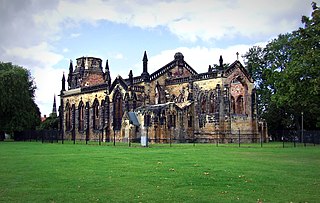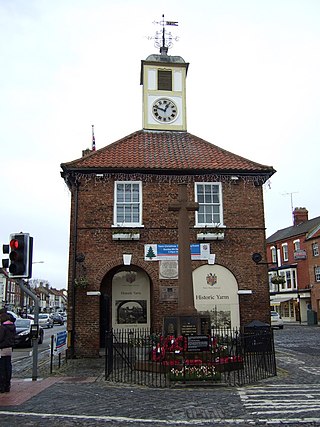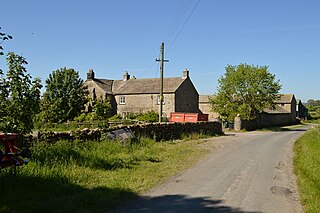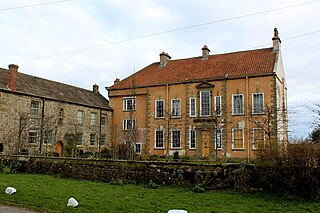
Darlington is a market and industrial town in County Durham, England. It is the main administrative centre of the unitary authority Borough of Darlington. The borough is a constituent member of the devolved Tees Valley area.

Allerton Castle, also known as Allerton Park, is a Grade I listed nineteenth-century Gothic or Victorian Gothic house at Allerton Mauleverer in North Yorkshire, England. It was rebuilt by architect George Martin, of Baker Street, London in 1843–53.

Richmond railway station was a railway station that served the town of Richmond in North Yorkshire, England. The station was the terminus of a branch line that connected with what would become the East Coast Main Line.
Catterick Bridge is a hamlet about 1 mile north of Catterick, at the south end of Catterick road bridge.

Walworth Castle is a castle of 12th-century origins, situated at Walworth, near Darlington, County Durham, England. It is a Grade 1 listed building. It was completed around 1600, probably by Thomas Holt for Thomas Jenison. It stands on the site of a former manor house or castle built in the 12th century by the Hansard family. The estate passed through the hands of the Ayscoughs and Aylmers besides the Hansards and Jenisons, and became a prisoner-of-war camp during World War II and then a girls' boarding school after the war. It has been a hotel since 1981.

The Monroe Avenue Commercial Buildings, also known as the Monroe Block, is a historic district located along a block-and-a-half stretch at 16-118 Monroe Avenue in Detroit, Michigan, just off Woodward Avenue at the northern end of Campus Martius. The district was designated a Michigan State Historic Site in 1974 and listed on the National Register of Historic Places in 1975. The thirteen original buildings were built between 1852 and 1911 and ranged from two to five stories in height. The National Theatre, built in 1911, was the oldest surviving theatre in Detroit, a part of the city's original theatre district of the late 19th century, and the sole surviving structure from the original Monroe Avenue Commercial Buildings historic period.

Thornton Manor is a large manor house in the village of Thornton Hough, Wirral, Merseyside, England. It is recorded in the National Heritage List for England as a designated Grade II* listed building. The house was first built in the middle of the 19th century and has been altered and extended in a number of phases since. From 1888 to the end of the 20th century the house was occupied by the Viscounts Leverhulme.

Hangleton Manor Inn, the adjoining Old Manor House and associated buildings form a bar and restaurant complex in Hangleton, an ancient village which is part of the English city of Brighton and Hove. The manor house is the oldest secular building in the Hove part of the city; some 15th-century features remain, and there has been little change since the High Sheriff of Sussex rebuilt it in the mid-16th century. Local folklore asserts that a 17th-century dovecote in the grounds has been haunted since a monk placed a curse on it. The buildings that comprise the inn were acquired by Hangleton Manor Ltd in 1968, and converted to an inn under the Whitbread banner. The brewery company Hall & Woodhouse have owned and operated it since 2005. English Heritage has listed the complex at Grade II* for its architectural and historical importance, and the dovecote is listed separately at Grade II.

Trinity Green is a public park located on the edge of Stockton Town Centre in Stockton-on-Tees, England. The park is dominated by the preserved ruins and Grade II* listed building of Holy Trinity Church which was gutted by fire in Autumn 1991. Trinity Green was given to the town of Stockton by Bishop William van Mildert at the start of the 19th century, and now serves a space open to the public, hosting occasional cultural and community events.
Lymm Hall is a moated country house in the village suburb of Lymm in Warrington, Cheshire, England. It is recorded in the National Heritage List for England as a designated Grade II* listed building.

The Theatre Royal in Manchester, England, opened in 1845. Situated next to the Free Trade Hall, it is the oldest surviving theatre in Manchester. It was commissioned by Mancunian businessman John Knowles who wanted a theatre venue in the city.

Moulsecoomb Place is a large 18th-century house on Lewes Road in the Moulsecoomb area of the English coastal city of Brighton and Hove. Originally a farmhouse based in an agricultural area in the parish of Patcham, north of Brighton, it was bought and extensively remodelled in 1790 for a long-established local family. It was their seat for over 100 years, but the Neoclassical-style mansion and its grounds were bought by the local council in the interwar period when Moulsecoomb was transformed into a major council estate. Subsequent uses have varied, and Moulsecoomb Place later became part of the University of Brighton's range of buildings. Student housing has been built to the rear; but much of the grounds, the house itself and a much older cottage and barn attached to the rear have been preserved. The house is a Grade II Listed building.

The Church of St Anne is a parish church in the village of Catterick, North Yorkshire, England. The present church structure dates back to the early 15th century, but some of its stones are from an earlier structure located on the same site. A place of worship in Catterick village is believed to have been in existence since the 7th century. The church has been dedicated to Saint Anne since its original consecration date of 1415.

Corn exchanges are distinct buildings which were originally created as a venue for corn merchants to meet and arrange pricing with farmers for the sale of wheat, barley, and other corn crops. The word "corn" in British English denotes all cereal grains, such as wheat and barley. With the repeal of the Corn Laws in 1846, a large number of corn exchanges were built in England, particularly in the corn-growing areas of Eastern England.

The Catterick Bridge Explosion occurred on 4 February 1944 in the railway sidings at Catterick Bridge station, on the Richmond Branch Line/Catterick Camp Railway in North Yorkshire, England. It killed twelve people and injured more than a hundred. The incorrect loading of explosives into railway wagons is believed to have been the cause, but because of wartime restrictions, reporting of the event was not as widespread as it would have been had the explosion occurred in peacetime.

Yarm Town Hall is a municipal building in the High Street in Yarm, North Yorkshire, England. The structure, which is the meeting place of Yarm Town Council, is a Grade II listed building.

West End House is a historic building in Askrigg, a village in North Yorkshire, in England.

Barden Old Hall is a historic building in Barden, a hamlet near Richmond, North Yorkshire, in England.

Spout House is a historic building in Bilsdale, a valley in North Yorkshire, in England.

Cowling Hall is a historic building in Cowling, a village near Bedale in North Yorkshire, in England.


















